Quote
I like making images that from a distance seem kind of seductive, colorful, luscious and engaging, and then you realise what you're looking at is something totally opposite. It seems boring to me to pursue the typical idea of beauty, because that is the easiest and the most obvious way to see the world. It's more challenging to look at the other side.
Cindy Sherman
4 notes
·
View notes
Photo
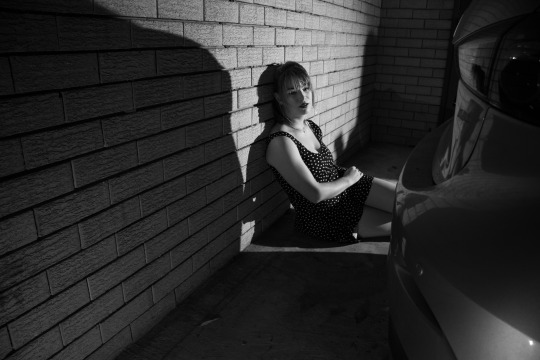
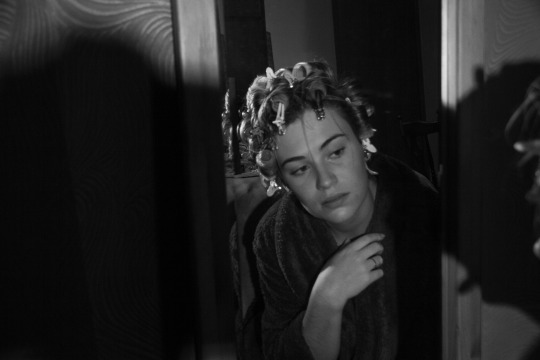
CAVA201: Photography
Journal Update: Looking Forward Looking Back
During the past few months I’ve been working with the general concept of conceptual alchemy related to identity - more specifically exploring female empowerment and the internal struggle between femininity and strength where it seems that the only way for a girl to get attention is with her body and not her mind.
Recently, I’ve been expressing this concept through a Marilyn Munroe-inspired theme of glamour and hidden misery by re-staging classic 1950s and 1960s films such as Sabrina (top photo) and original compositions like the bottom photo (for a bit more freedom than merely replicating existing works).
Lately, I’ve been in a bit of a rut for ideas moving forward and I’ve felt like I’d lost sight of what I wanted to achieve when I started this project. I’ve got a lot of thoughts whirring around and vague ideas that are hard to grasp and then turn into a work of some kind, so I’m taking this as a moment to word vomit and see where it takes me...
I’d like to explore further different ways of working with light sources - and how the photo may change in quality between daytime, dusk and nighttime, and perhaps make a makeshift outdoor studio to really take advantage of natural light. So far, I’ve been relying on a strong desk lamp for light when taking photos at night. Years ago, I used to use streetlights when shooting outside at night, and I feel like it’s time to revisit that method - especially since I’m very interested in unsettling effects caused by interesting ways of using light.
I know that this darkened kind of photo is effective in expressing a sense of loneliness and vulnerability and perhaps a hint of voyeurism... Bill Henson might be proud. In the future, I’m planning on exploring scenes of a girl after a night out and the sudden awareness of being alone and the longing to find a sense of belonging again after spending so much time looking for a sense of self amongst strangers. Perhaps I’ll extend this to daily mundane activities for an added sense of the relationship between the physical self and the intangible emotional and intellectual self.
#art process#art diary#photography#artists on tumblr#original art#concept art#art student#photographers on tumblr#art#word vomit#femininity#surrealism
0 notes
Photo

CAVA202: Painting
The development of Marcel Duchamp’s painting style has been useful inspiration for my work. “Nude Descending a Staircase No. 2” shows a study of movement that featured in his work for some time. It also shows cubist features but also ignores the rules of orthodox cubism. It also ignores the then art conventions related to the nude - the male nude would pose heroically and the female nude would recline to display a sense of sensuality - walking down the stairs seemed a mundane act to paint.
The study itself of movement is inspiring in its rejection of traditional constructions of painting and the sense of freedom it gives when working with paint. It has spurred my curiosity towards cubism and abstraction and their usefulness in ignoring rules like anatomy and ideals in aesthetics drawn from realism.
Duchamp, M (1912), Nude Descending a Staircase No. 2, image, viewed 19 May 2020, <https://www.tate.org.uk/whats-on/tate-modern/exhibition/duchamp-man-ray-picabia/explore-exhibition/room-3-movement>.
0 notes
Text
Thoughts and Confusion
CAVA202: Painting
Ok I’m just gonna word vomit all the thoughts whirring about my head about this project. What I know for sure is that it is called “Dreams & Doubts”. The concept is an exploration of my personal fears and doubts of being enough for my aspirations in life and as a functioning human in general. This absolutely stems from being an introvert in a world where it feels like extroversion is a more highly valued trait. The process, so far, has been about coming to terms with these feelings I have about myself and slowly slowly disregarding my worries about how everyone else may see me and kinda taking back the power from those parts with my head that like to mess with me.
Being relatively new to (acrylic) painting as a medium (I’m more naturally into photography), I’ve been struggling consolidating all the ideas and images and motifs in my head into idk like a clear image of what I want to put onto the page? I’m not sure what kind of process everyone else goes through but I utterly hate planning what I’m gonna do when I’m making art.
I’ve been moving away from realism, literal concepts and even surrealist approaches (even though I love surrealism - gotta move away from being literal atm) in my experiments and have found some inspiration in artists working with abstraction... I’ve figured how underrated just working with colour is without the tediousness of working with forms and figures. It’s been therapeutic...
#artists on tumblr#painting#acrylic painting#art student#traditional art#art process#dreams and doubts#art#artist#colour#abstraction
0 notes
Photo
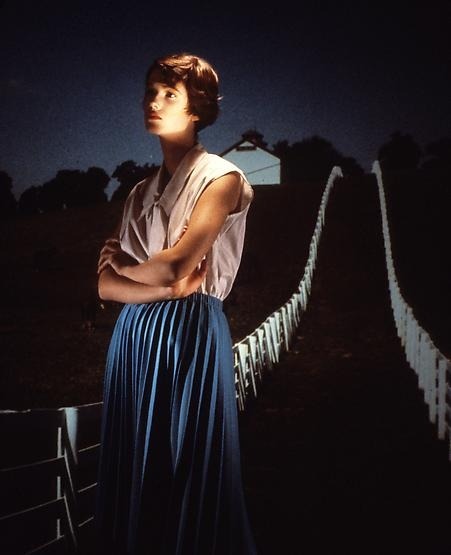
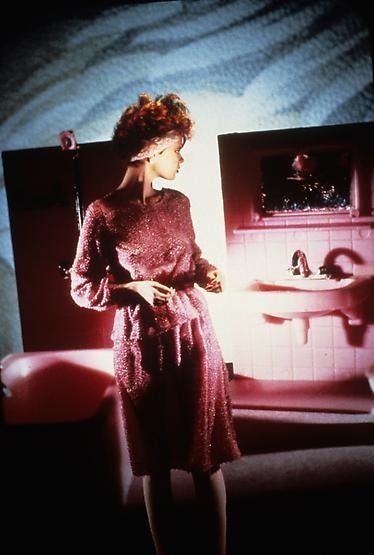
CAVA201: Photography
In the process of researching artists for my current photography project focusing on turning back the male gaze... I’ve hit a bit of a rut lately but I’ve found these works from Laurie Simmons’ ‘Fake Fashion’ series very inspiring in terms of setting up scenes for staged photography. I’ve always been more of a found scene photography kinda gal so this process is new to me.
The strong spot lighting and high contrast in these works strike a chord with me so I’m thinking about how I can use lamps and flashlights to replicate this kind of lighting for my experiments re-staging scenes from classic 1950′s and 1960′s Hollywood movies... Watch this space.
Simmons, L 1984, Country Road, Kentucky, image, Laurie Simmons, viewed 8 May 2020, <http://www.lauriesimmons.net/photographs/fake-fashion?view=slider#6>.
Simmons, L 1984, Pink Bathroom, image, Laurie Simmons, viewed 8 May 2020, <http://www.lauriesimmons.net/photographs/fake-fashion?view=slider#7>.
#artists on tumblr#artist process#art inspiration#photography#portrait photography#art#staged photography
0 notes
Text
Idk why it took me this long to realise that i can just look up poses for drawing anatomy... MIND BLOWN
So long, agonising over the insecurity that I should probably learn some damn anatomy before drawing a person
2 notes
·
View notes
Text
References
Barker, C 2012, ‘Cultural Studies: Theory and Practice’, 4th ed., Sage, London.
Whiteley, B 1976 Self Portrait in the Studio, image, Art Gallery NSW, viewed, 21 March 2019, <https://www.artgallery.nsw.gov.au/collection/works/1.1977/>.
Art Gallery NSW n.d., ‘Self Portrait in the Studio’, Art Gallery of NSW, weblog post, n.d., viewed 21 March 2019, <https://www.artgallery.nsw.gov.au/collection/works/1.1977/>.
Kafouros, E 2011, How Did I Get Here, image, Elias Kafouros, viewed 21 March 2019, <http://epitome.xyz/meet/elias-kafouros-painting-the-unmeasurable/>.
Kandinsky, W 1910–1, Cossacks, image, Tate, viewed 22 March 2019, <https://www.tate.org.uk/art/artworks/kandinsky-cossacks-n04948>.
Kandinsky, W 1912, ‘Concerning the Spiritual in Art’, Morgan Press Inc., Hastings-on-Hudson, NY.
Mansfield, N 2000, ‘Subjectivity: Theories of the Self from Freud to Haraway’, Allen & Unwin, St. Leonards, NSW.
Olley, M 2007, The Yellow Room Triptych, image, S H Ervin Gallery, viewed 23 March 2019, <https://www.shervingallery.com.au/event/margaret-olley-painter-peer-mentor-muse/>.
Howes, D 2005, ‘Skinscapes: Embodiment, Culture and Environment’, in Classen, Constance The Book of Touch, Berg, Oxford.
Boyd, D 2014, Untitled, image, Art Gallery NSW, viewed 25 March 2019, <https://www.artgallery.nsw.gov.au/collection/works/92.2014/>.
Harrison, C, Wood, P 2003, ‘Art in theory 1900-2000: an anthology of changing ideas’, Blackwell Publishing, Malden.
Monet, C 1872, Impression, Sunrise, image, National Gallery of Australia, viewed 26 March, <https://nga.gov.au/impressionsunrise/>.
Isaacson, J 1978, ‘Claude Monet: Observation and Reflection’, Phaidon Press Limited, Oxford.
Bennet, A, Royle, N 2016, ‘An introduction to literature, criticism and theory’, 5th edn, Routeldge, New York.
Quilty, B 2012, Self Portrait After Afghanistan 3, image, Jan Murphy Gallery, <http://www.janmurphygallery.com.au/artist/ben-quilty/selected-works/#s5970>.
McGregor, L 2008, I’m Not Here, image, NGV, viewed 26 March 2019, <https://www.ngv.vic.gov.au/explore/collection/work/90362/>.
Art Gallery of NSW n.d., ‘The Art that made Laith McGregor’, Art Gallery NSW, weblog post, viewed 26 March 2019, <https://www.artgallery.nsw.gov.au/artsets/tjm3be>.
Austin, A n.d., ‘Laith McGregor: Through Blue Biro Eyes’, Iris Magazine, weblog post, viewed 26 March 2019, <https://www.irismagazine.com/issue-one/laith-mcgregor>.
Henson, B 1980–2, Untitled 1980/82, image, NGV, viewed 27 March 2019, <https://www.ngv.vic.gov.au/explore/collection/work/13163/>.
McDonald, M 2011, ‘It’s Rude to Stare: Bill Henson Revisited’, Artlink, weblog post, viewed 27 March 2019, <https://www.artlink.com.au/articles/3651/its-rude-to-stare-bill-henson-revisited/>.
Hall, S, Held, D, Hubert, D, Thompson, K 1996, ‘Modernity: an introduction to modern societies’, Blackwell Publishers, Oxford.
Celmins, V 1975, Ocean, image, Tate, viewed 27 March 2019, <https://www.tate.org.uk/art/artworks/celmins-ocean-p78336>.
Manchester, E 2005, ‘Vija Celmins: Ocean’, Tate, weblog post, viewed 27 March 2019, <https://www.tate.org.uk/art/artworks/celmins-ocean-p78336>.
0 notes
Photo

‘Identity is about sameness and difference, about the personal and the social, “about what you have in common with some people and what differentiates you from others”’ (Barker 2012 quoting Weeks 1990, p. 223).
Social Identity can be identified as spinning a narrative about oneself based upon a comparison with others to discover what determines the nature of one’s identity.
Vija Celmins has developed her own meticulous drawing technique depicting the surface texture of areas of sea such as in the work ‘Ocean’ (1975) to create an impression of space and depth (Manchester 2005). The technique characterises her work as her unique rendition of a classic seascape.
0 notes
Photo

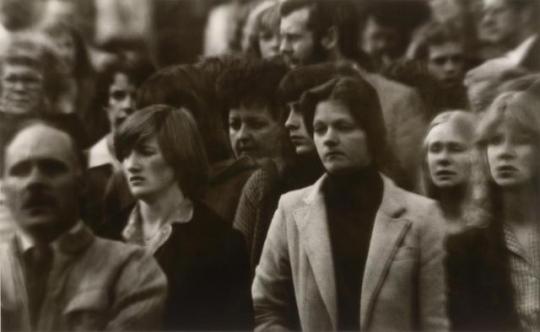
‘The subject previously experienced as having a unified and stable identity, is becoming fragmented; composed, not of a single, but of several, sometimes contradictory or unresolved, identities’ (Hall 1996, p. 598).
Fractured Identity stems from the conceptualisation of identity (Barker 2012, p. 223). Therefore, the shifting of these identities between circumstances depends on the dominance of each identity of the subject.
Bill Henson’s photographic series ‘Untitled 1980/82′ (1980-82) builds upon this concept by forcing the audience to become a voyeur of strangers unaware of our gaze. The identity of these strangers can only be based upon their appearance to be ‘fleetingly attractive, menacing or innocent’ (McDonald 2011).
0 notes
Photo
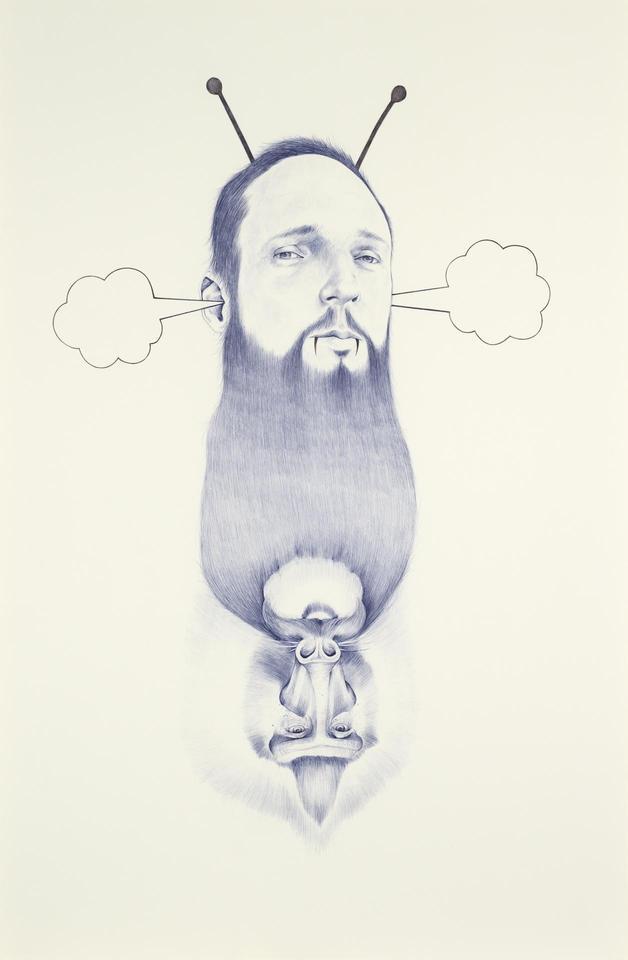
‘I see my work as a long, drawn-out continuous narrative, slowly unravelling and revealing aspects of myself, my immediate surroundings and thoughts’ (Art Gallery of NSW quoting Laith McGregor n.d.)
Creative Identity is the intersection between self-identity and creative influence where the creative self ‘unravels’ through one’s practice. Therefore, the artist’s creative identity only becomes clear -both to the artist and the audience- through the creative process and the body of work, itself.
Laith McGregor’s ‘I’m not here’ (2008) is an example of how he instils a little bit of himself in each work, causing it to convey an unsettling amount of emotional value (Austin n.d.).
0 notes
Photo
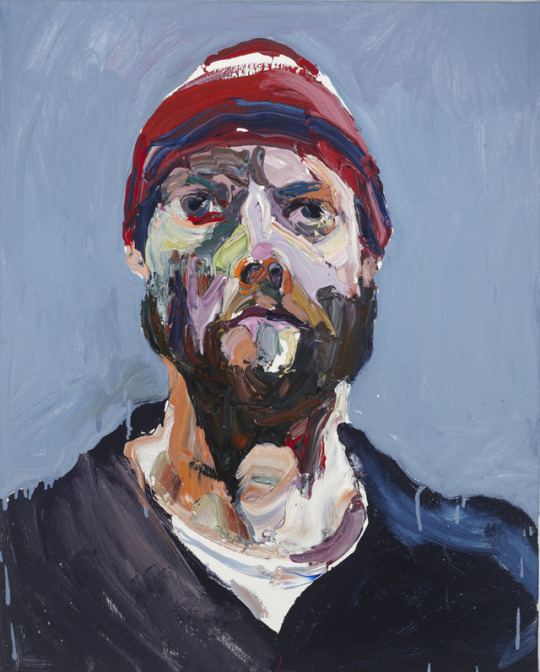
'There are two meanings of the word “subject”: subject to to someone else by control and dependence; and tied to one’s own identity by a conscience or a self-knowledge’ (Bennet & Royle 2016 quoting Foucault 1983, p. 151).
Authenticity occurs when self-identity aligns with self-awareness. It may be argued that the two concepts are in fact one and the same but the reasoning for this would be the occurrence of authenticity, so all that can be proven is that the three concepts are inevitably interconnected.
Ben Quilty’s ‘Self Portrait after Afghanistan 3′ (2012) turns a critical eye to the self and how it has changed so intensely without giving the conscious mind time to adjust to the new self.
0 notes
Photo

‘To “make one’s name” means making one’s mark, achieving recognition... of one’s difference from others, especially the most consecrated of them’ (Bourdieu in Harrison & Wood 2003, p. 1021).
Creative Influence is the reason we, as artists, strive to improve the resolution of our work to connect with our audience and, hopefully, prove to ourselves that our creative self matches our creative idols.
Hence, appropriation is extremely effective in the creative world as it reinvents old ideas in the pursuit of ‘making one’s mark’. Else, like Claude Monet with ‘Impression, Sunrise’ (1873) after being rejected by the prestigious Salon exhibition, we create an entirely new perspective towards the creative world (Isaacson 1978, p. 8).
0 notes
Photo

‘When my feet felt the path which my eyes could not see... I have thought that perhaps my body would find its way home if its master should forsake it...’ (Howes 2005 quoting Thoreau 1968, p. 27)
Sensory Knowledge is the name given to the contemplation of the existence of a tactile knowledge of one’s surroundings - a knowledge of the senses beyond what the conscious mind can comprehend.
Daniel Boyd’s ‘Untitled’ (2014) presents this concept as culturally entrenched by using a found photograph of Pentecost Island in Vanuatu to address the connection between the land and its inhabitants as well as their respective histories (Art Gallery of NSW n.d.).
0 notes
Photo
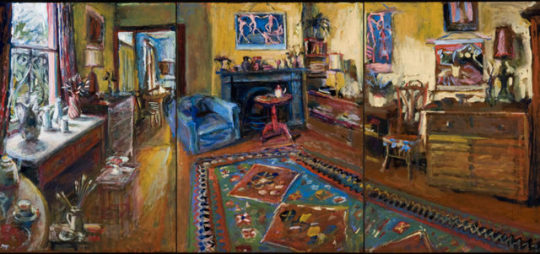
Overdetermination can be described as the ‘expression of the most plural and deep psychological complexity’ found in seemingly trivial behaviours such as the tendency to click a pen or bite one’s nails . This derives from the energy of the unconscious ‘spilling’ into the conscious mind as ‘trivial’ impulses which actually are the expression of our ‘deepest experiences and investments’ (Mansfield 2000, p. 29).
Margaret Olley’s triptych ‘The Yellow Room’ (2007) is an emotionally charged painting of the artist’s living room. The bright colours and expressive brushstrokes imply her love for the space as it served as her studio, entertaining space and storage for memorabilia of her travels.
0 notes
Photo

The unconscious is the key concept at the core of Sigmund Freud’s work on psychoanalysis due to its allure as a solution for the unexplained gaps in the conscious mind but also its ability to evade total comprehension itself. It is best explained through the following quote on its expression in dreams:
‘Freud saw in dreams the existence not only of a part of the mind in shadow of conscious awareness, but one that was so radically different... to consciousness’ (Mansfield 2000, p. 28).
Wassily Kandinsky’s obsessive work with colour in ‘Cossacks’ (1910-1) relates to the unconscious in that Kandinsky refers to the effect of colour as ‘to a more sensitive soul... is deeper and intensely moving’ (Kandinsky 1912, p. 44).
0 notes
Photo

Essentialism is the theory that a person’s identity comes from an ‘essence of self’ that is fixed in nature. The theory is in opposition to anti-essentialism which argues that identity is malleable by cultural factors rather than something to be ‘found’, as explained in (Barker 2012, p. 221).
These ideas relate to the mesmerising symbols found in Elias Kafouras’ ‘How Did I Get Here?’ (2011) due to their mandala-like overlapping, creating a flowing narrative of images. In this way, it could be argued that the work demonstrates both opposing theories as it is difficult to differentiate between what is discovered and what has been created, particularly when it comes to the self.
0 notes
Photo
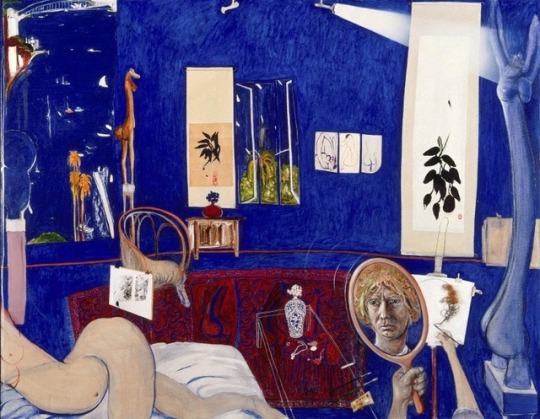
Subjectivity may be explored as a concept through the relationship of the human condition and the cultural constructions that we, the subjects, exist within, as described in (Barker 2012, p. 220). It cannot be defined as identity itself but rather how we experience identity as well as the process of becoming aware of the nature of our identity.
Brett Whiteley’s ‘Self Portrait in the Studio’ hints at this idea through his mirror self-portrait that individuals are subject to and are one with a larger cultural landscape. The artist’s intention, however, warns against ‘himself and other people watching... [the dangers of] possible escape into paradise: the escape from one’s psyche’ (Art Gallery of NSW, n.d.).
1 note
·
View note